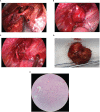Case report: Combined cervical incision with an intercostal uniportal video-assisted thoracoscopic surgery approach for mediastinal brachial plexus schwannoma
- PMID: 37377912
- PMCID: PMC10291177
- DOI: 10.3389/fonc.2023.1168963
Case report: Combined cervical incision with an intercostal uniportal video-assisted thoracoscopic surgery approach for mediastinal brachial plexus schwannoma
Abstract
Mediastinal neurogenic tumors primarily originate from the intercostal and sympathetic nerves, whereas schwannomas originating from the brachial plexus are rare. Surgical intervention for such tumors is complex and associated with the risk of postoperative upper limb dysfunction due to their unique anatomical location. In this report, we present the case of a 21-year-old female diagnosed with a mediastinal schwannoma, who underwent a novel surgical approach combining cervical incision and intercostal uniportal video-assisted thoracoscopic surgery (VATS). Our study reviewed the patient's clinical presentation, treatment approach, pathology, and prognosis. The findings of this study demonstrate that the cervical approach, combined with intercostal uniportal VATS, is a feasible surgical method for the removal of mediastinal schwannomas originating from the brachial plexus.
Keywords: brachial plexus; faster rehabilitation.; minimally invasive; schwannomas; uniportal video-assisted thoracoscopic surgery.
Copyright © 2023 Wang, Ge and Ren.
Conflict of interest statement
The authors declare that the research was conducted in the absence of any commercial or financial relationships that could be construed as a potential conflict of interest.
Figures




References
Publication types
LinkOut - more resources
Full Text Sources

